- GCN/BACODINE POSITION NOTICE
TITLE: GCN/SWIFT NOTICE
NOTICE_DATE: Fri 17 Feb 23 21:53:21 UT
NOTICE_TYPE: Swift-BAT GRB Position
TRIGGER_NUM: 1154967, Seg_Num: 0
GRB_RA: 280.771d {+18h 43m 05s} (J2000),
281.137d {+18h 44m 33s} (current),
279.979d {+18h 39m 55s} (1950)
GRB_DEC: -28.856d {-28d 51' 19"} (J2000),
-28.831d {-28d 49' 51"} (current),
-28.906d {-28d 54' 20"} (1950)
GRB_ERROR: 3.00 [arcmin radius, statistical only]
GRB_INTEN: 986 [cnts] Image_Peak=84 [image_cnts]
TRIGGER_DUR: 0.064 [sec]
TRIGGER_INDEX: 10427 E_range: 50-350 keV
BKG_INTEN: 7108 [cnts]
BKG_TIME: 78777.22 SOD {21:52:57.22} UT
BKG_DUR: 8 [sec]
GRB_DATE: 19992 TJD; 48 DOY; 23/02/17
GRB_TIME: 78790.66 SOD {21:53:10.66} UT
GRB_PHI: -18.03 [deg]
GRB_THETA: 49.15 [deg]
SOLN_STATUS: 0x3
RATE_SIGNIF: 111.45 [sigma]
IMAGE_SIGNIF: 8.87 [sigma]
MERIT_PARAMS: +1 +0 +0 -4 +3 -1 -5 +1 -64 +0
SUN_POSTN: 331.11d {+22h 04m 26s} -11.83d {-11d 49' 46"}
SUN_DIST: 49.43 [deg] Sun_angle= 3.3 [hr] (West of Sun)
MOON_POSTN: 298.39d {+19h 53m 33s} -25.91d {-25d 54' 19"}
MOON_DIST: 15.58 [deg]
MOON_ILLUM: 8 [%]
GAL_COORDS: 6.03,-11.05 [deg] galactic lon,lat of the burst (or transient)
ECL_COORDS: 279.47, -5.77 [deg] ecliptic lon,lat of the burst (or transient)
COMMENTS: SWIFT-BAT GRB Coordinates.
COMMENTS: This is a rate trigger.
COMMENTS: A point_source was found.
COMMENTS: This does not match any source in the on-board catalog.
COMMENTS: This does not match any source in the ground catalog.
COMMENTS: This is a GRB.
COMMENTS: This trigger occurred at longitude,latitude = 203.95,-18.82 [deg].
- red DSS finding chart
ps-file
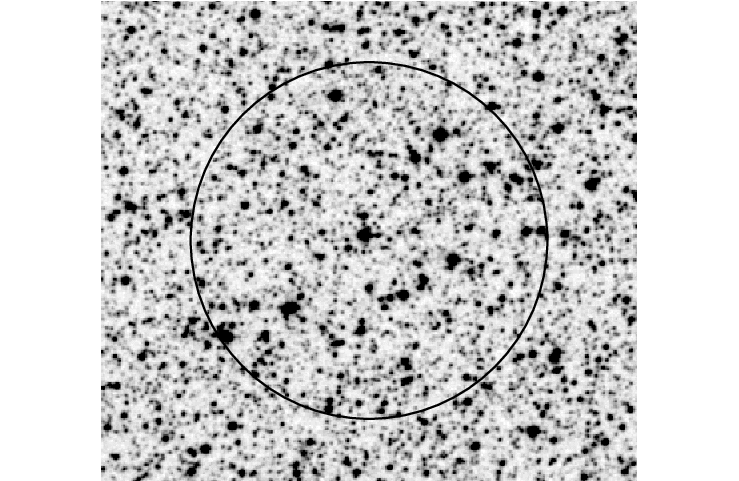
- GCN NOTICE
TITLE: GCN/SWIFT NOTICE
NOTICE_DATE: Fri 17 Feb 23 21:57:34 UT
NOTICE_TYPE: Swift-BAT GRB Lightcurve
TRIGGER_NUM: 1154967, Seg_Num: 0
GRB_RA: 280.771d {+18h 43m 05s} (J2000),
281.137d {+18h 44m 33s} (current),
279.979d {+18h 39m 55s} (1950)
GRB_DEC: -28.856d {-28d 51' 19"} (J2000),
-28.831d {-28d 49' 51"} (current),
-28.906d {-28d 54' 20"} (1950)
GRB_DATE: 19992 TJD; 48 DOY; 23/02/17
GRB_TIME: 78790.90 SOD {21:53:10.90} UT
TRIGGER_INDEX: 10427
GRB_PHI: -18.03 [deg]
GRB_THETA: 49.15 [deg]
DELTA_TIME: 72.00 [sec]
TRIGGER_DUR: 0.064 [sec]
SOLN_STATUS: 0x3
RATE_SIGNIF: 111.45 [sigma]
IMAGE_SIGNIF: 8.87 [sigma]
LC_URL: sw01154967000msb.lc
SUN_POSTN: 331.11d {+22h 04m 26s} -11.83d {-11d 49' 42"}
SUN_DIST: 49.43 [deg] Sun_angle= 3.3 [hr] (West of Sun)
MOON_POSTN: 298.44d {+19h 53m 45s} -25.90d {-25d 53' 51"}
MOON_DIST: 15.63 [deg]
MOON_ILLUM: 8 [%]
GAL_COORDS: 6.03,-11.05 [deg] galactic lon,lat of the burst (or transient)
ECL_COORDS: 279.47, -5.77 [deg] ecliptic lon,lat of the burst (or transient)
COMMENTS: SWIFT-BAT GRB Lightcurve.
COMMENTS:
COMMENTS: The next comments were copied from the BAT_POS Notice:
COMMENTS: This is a rate trigger.
COMMENTS: A point_source was found.
COMMENTS: This does not match any source in the on-board catalog.
COMMENTS: This does not match any source in the ground catalog.
COMMENTS: This is a GRB.
COMMENTS: This trigger occurred at longitude,latitude = 203.95,-18.82 [deg].
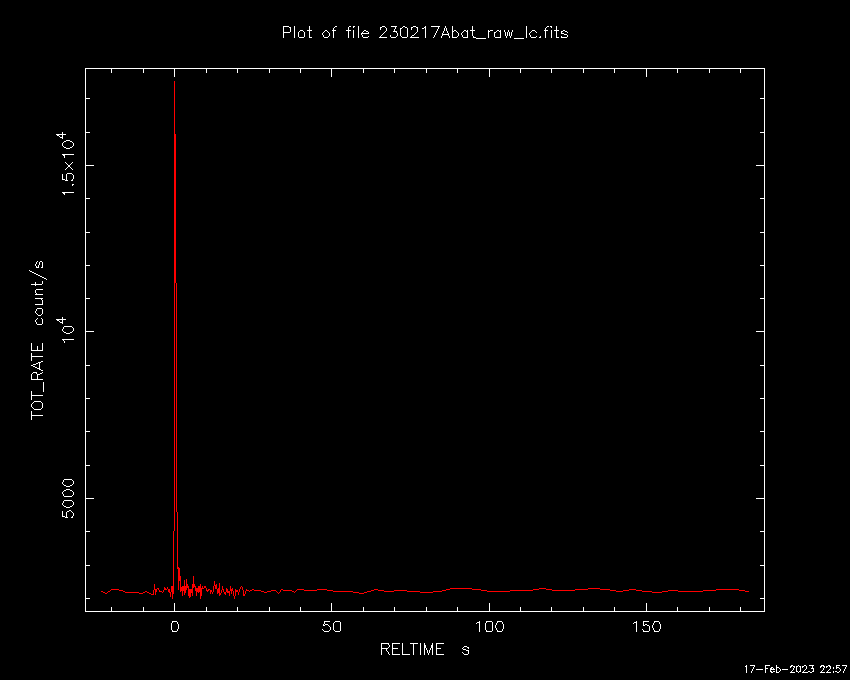
- GCN Circular #33338
The Fermi GBM team reports the detection of a likely LONG GRB
At 21:53:10 UT on 17 Feb 2023, the Fermi Gamma-ray Burst Monitor (GBM) triggered and located GRB 230217A (trigger 698363595.689472 / 230217912).
The on-ground calculated location, using the Fermi GBM trigger data, is RA = 278.8, Dec = -27.4 (J2000 degrees, equivalent to J2000 18h 35m, -27d 23'), with a statistical uncertainty of 1.0 degrees.
The angle from the Fermi LAT boresight is 56.0 degrees.
The skymap can be found here:
https://heasarc.gsfc.nasa.gov/FTP/fermi/data/gbm/triggers/2023/bn230217912/quicklook/glg_skymap_all_bn230217912.png
The HEALPix FITS file, including the estimated localization systematic, can be found here:
https://heasarc.gsfc.nasa.gov/FTP/fermi/data/gbm/triggers/2023/bn230217912/quicklook/glg_healpix_all_bn230217912.fit
The GBM light curve can be found here:
https://heasarc.gsfc.nasa.gov/FTP/fermi/data/gbm/triggers/2023/bn230217912/quicklook/glg_lc_medres34_bn230217912.gif
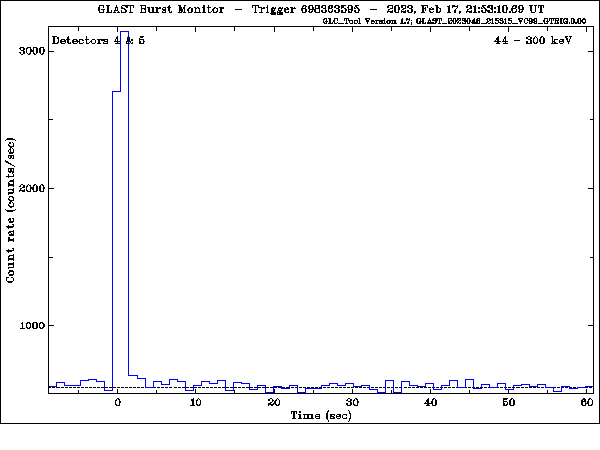
- GCN Circular #33339
M. J. Moss (GWU), R. A. J. Eyles-Ferris (U Leicester),
J.D. Gropp (PSU), H. A. Krimm (NSF), F. E. Marshall (NASA/GSFC),
K. L. Page (U Leicester), B. Sbarufatti (INAF-OAB) and
M. A. Williams (PSU) report on behalf of the Neil Gehrels Swift
Observatory Team:
At 21:53:10 UT, the Swift Burst Alert Telescope (BAT) triggered and
located GRB 230217A (trigger=1154967). Swift did not slew to the burst
due to an observing constraint.
The BAT on-board calculated location is
RA, Dec 280.771, -28.856 which is
RA(J2000) = 18h 43m 05s
Dec(J2000) = -28d 51' 19"
with an uncertainty of 3 arcmin (radius, 90% containment, including
systematic uncertainty). The BAT light curve showed a single short
peak with a duration of about 1 sec. The peak count rate
was ~15000 counts/sec (15-350 keV), at ~0 sec after the trigger.
Due to a Moon observing constraint, Swift cannot slew to the BAT
position until 10:09 UT on 2023 February 18. There will thus be no
XRT or UVOT data for this trigger before this time.
Burst Advocate for this burst is M. J. Moss (mikejmoss3 AT gmail.com).
Please contact the BA by email if you require additional information
regarding Swift followup of this burst. In extremely urgent cases, after
trying the Burst Advocate, you can contact the Swift PI by phone (see
Swift TOO web site for information: http://www.swift.psu.edu/)
- GCN Circular #33343
C. Casentini (INAF/IAPS), F. Verrecchia (SSDC, and INAF/OAR), F. Longo
(Uni. Trieste, INFN Trieste) M. Tavani
(INAF/IAPS, and Univ. Roma Tor Vergata), C. Pittori, F. Lucarelli,
A. Argan, M. Cardillo, Y. Evangelista, L. Foffano, G. Piano
(INAF/IAPS), A. Addis, L. Baroncelli, A. Bulgarelli, A. Di Piano,
V. Fioretti, G. Panebianco, N. Parmiggiani (INAF/OAS-Bologna), M. Romani
(INAF/OA-Brera), M. Marisaldi (INAF/OAS-Bologna, Bergen University),
M. Pilia, A. Trois (INAF/OA Cagliari), I. Donnarumma, E. Menegoni,
A.Ursi (ASI), A. Giuliani (INAF/IASF-Mi) and P. Tempesta (TeleSpazio),
report on behalf of the AGILE Team:
The AGILE satellite detected the short GRB 230217A at
T0 = 2023-02-17 21:53:10.87 (UTC), reported by Fermi/GBM (GCN #33338) and
Swift BAT (GCN #33339).
The burst is clearly visible in the AGILE scientific ratemeters of the
MiniCALorimeter (MCAL; 0.4-100 MeV), and in all the panels of the
AntiCoincidence detectors (AC Top, 50-200 keV; AC Lat, 80-200 keV).
The event lasted about 2 s and it released a total number of 7554 counts
in the MCAL detector (above a background rate of 529 Hz), and 38605 counts
in the AC Top detector (above a background rate of 3530 Hz).
The AGILE ratemeters light curves can be found at:
http://www.agilescienceapp.it/notices/GRB230217A_AGILE_RM_ND.png .
The event also triggered a high-time resolution MCAL data acquisition,
from T0-0.7 s to T0+5.8 s (UTC), and released 2515 counts in the detector,
above a background rate of 776 Hz. The MCAL light curve can be found at:
http://www.agilescienceapp.it/notices/GRB230217A_082311_603755590.000000.png
.
The time-integrated spectrum of the burst between T0-1s and T0+1s, fitted
in the energy range 0.4-10 MeV with a p.l. with ph. ind. = -2.12 (+/-0.08)
resulting in a reduced chi-squared of 0.92 (48 d.o.f.)
and a fluence of 4.05e-06 ergs/cm^2 (90% confidence level),
in the same energy range.
At the T0, the event was 59 deg off-axis.
Additional analysis of AGILE data is in progress.
Automatic MCAL GRB alert Notices can be found at:
https://gcn.gsfc.nasa.gov/agile_mcal.html
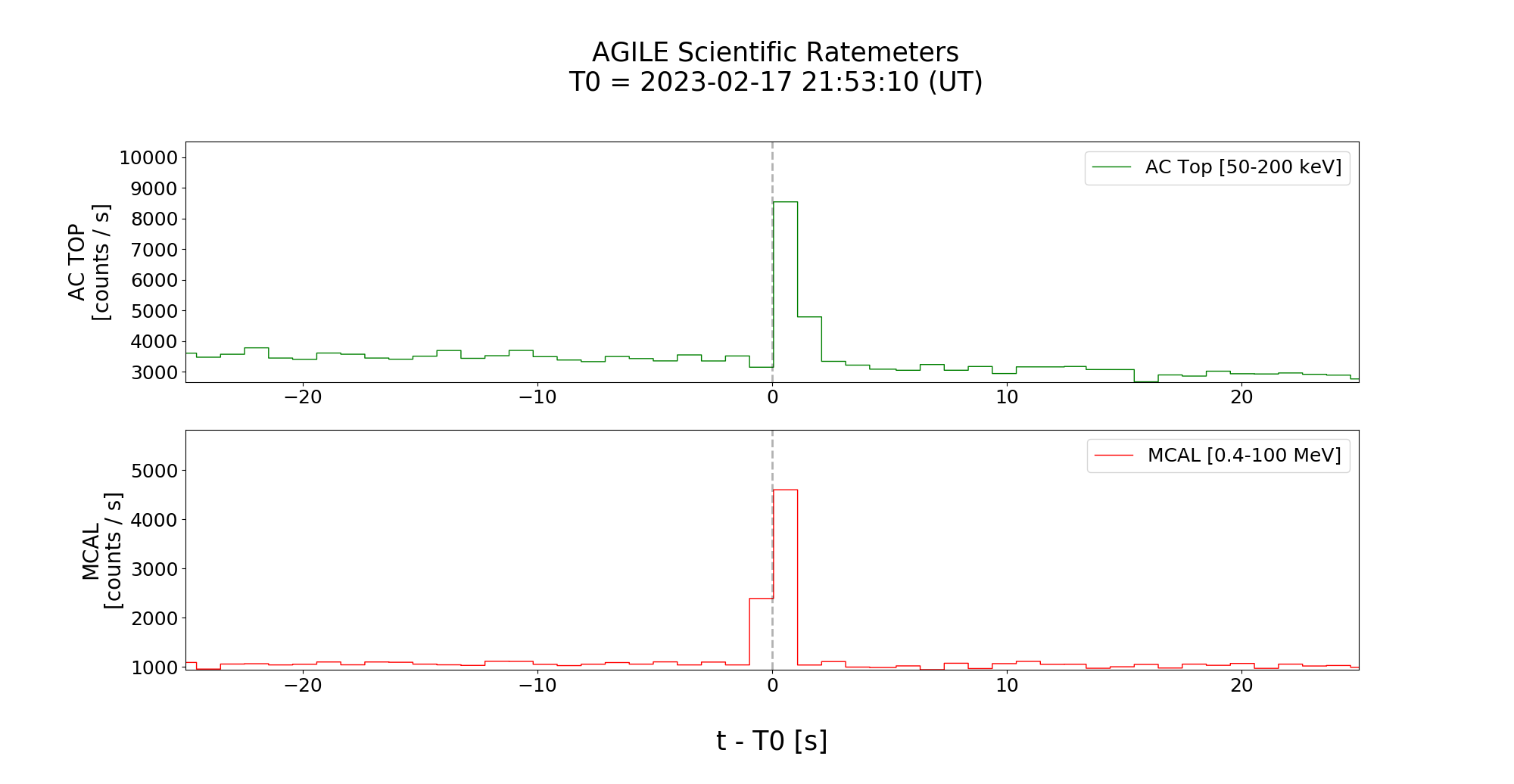
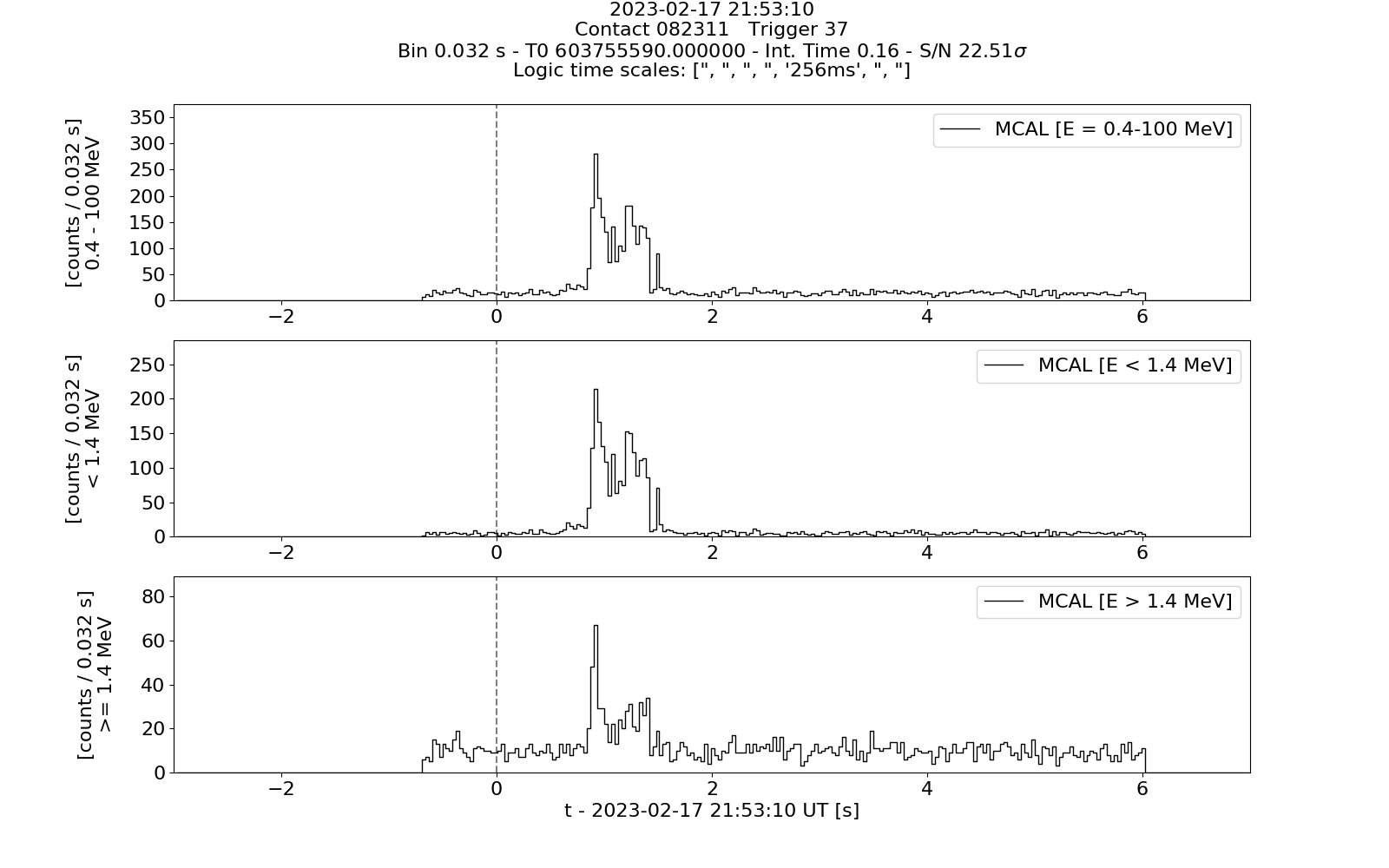
- GCN Circular #33348
M. Capalbi (INAF-IASFPA), J.A. Kennea (PSU), A. Tohuvavohu (U.
Toronto), D.N. Burrows (PSU), K.L. Page (U. Leicester), A.P. Beardmore
(U. Leicester), M. Perri (SSDC & INAF-OAR), V. D'Elia (SSDC & INAF-OAR)
and M. J. Moss (GWU) report on behalf of the Swift-XRT team:
We have analysed 4.8 ks of Photon Counting (PC) mode XRT data for the
Swift-BAT-detected burst GRB 230217A (Moss et al. GCN Circ. 33339),
collected between T0+45.8 ks and T0+84.4 ks.
Two uncatalogued X-ray sources have been detected consistent with being
within 296 arcsec of the Swift-BAT position, however none of them is
above the RASS limit or shows definitive signs of fading. Therefore, at
the present time we cannot identify which, if any, is the afterglow.
Details of these sources are given below:
Source 3:
RA (J2000.0): 280.7700 = 18:43:4.80
Dec (J2000.0): -28.8374 = -28:50:14.6
Error: 4.7 arcsec (radius, 90% conf. [Enhanced position])
Count-rate: 0.0144 [+0.0022, -0.0021] ct s^-1
Distance: 67 arcsec from Swift-BAT position.
Flux: (6.48 [+0.98, -0.94])e-13 erg cm^-2 s^-1 (observed, 0.3-10 keV)
Source 5:
RA (J2000.0): 280.7763 = 18:43:6.30
Dec (J2000.0): -28.7796 = -28:46:46.7
Error: 6.4 arcsec (radius, 90% conf.)
Count-rate: (1.43 [+0.85, -0.64])e-3 ct s^-1
Distance: 275 arcsec from Swift-BAT position.
Six uncatalogued sources were also detected too far from the GRB
position to be likely afterglow candidates.
The results of the XRT-team automatic analysis of the XRT observations,
including a position-specific upper limit calculator, are available at
https://www.swift.ac.uk/ToO_GRBs/01154967.
This circular is an official product of the Swift-XRT team.
- GCN Circular #33349
D. Svinkin, D. Frederiks, M. Ulanov, A. Tsvetkova,
A. Lysenko, A. Ridnaia, and T. Cline
on behalf of the Konus-Wind team, report:
The short-duration GRB 230217A
(Fermi-GBM detectin: The Fermi-GBM team, GCN Circ. 33338;
Swift-BAT detection: Moss et al., GCN Circ. 33339;
CALET-GBM detection: Torii et al., GCN Circ. 33342;
AGILE-MCAL detection: Casentini et al., GCN Circ. 33343)
triggered Konus-Wind at T0=78786.119 s UT (21:53:06.119).
The burst light curve shows a multi-peaked structure
which starts at ~T0-0.2 s and has a total duration of ~0.9 s.
The emission is seen up to ~6 MeV.
The Konus-Wind light curve of this GRB is available at
http://www.ioffe.ru/LEA/GRBs/GRB230217_T78786/
As observed by Konus-Wind, the burst
had a fluence of 2.74(-0.35,+0.39)x10^-5 erg/cm2,
and a 16-ms peak flux, measured from T0+0.128 s,
of 9.45(-1.84,+1.94)x10^-5 erg/cm2/s
(both in the 20 keV - 10 MeV energy range).
The time-averaged spectrum of the burst
(measured from T0 to T0+8.448 s)
is best fit in the 20 keV - 10 MeV range
by a power law with exponential cutoff model:
dN/dE ~ (E^alpha)*exp(-E*(2+alpha)/Ep)
with alpha = -0.81(-0.13,+0.14)
and Ep = 1367(-240,+309) keV (chi2 = 105/98 dof).
Fitting by a GRB (Band) model yields the same alpha and Ep,
and an upper limit on the high energy photon index: beta <-2.7
(chi2 = 105/97 dof).
All the quoted errors are at the 90% confidence level.
All the quoted values are preliminary.
- GCN Circular #33353
P. Veres (UAH) reports on behalf of the Fermi GBM Team:
"At 21:53:10.69 UT on 17 February 2023, the Fermi Gamma-Ray Burst Monitor (GBM)
triggered and located GRB 230217A (trigger 698363595 / 230217912).
which was also detected by the Swift/BAT (Moss et al., GCN 33339),
AGILE (Casentini et al., GCN 33343), CALET-GBM (Torii et al., GCN
33342) and Konus-Wind (Svinkin et al., GCN 33349). The GBM on-ground
location is consistent with the Swift position.
The angle from the Fermi LAT boresight at the GBM trigger time is 58 degrees.
The GBM light curve consists of a single pulse
with a duration (T90) of about 0.90 s (50-300 keV).
The time-averaged spectrum from T0s to T0+1.4 s is
best fit by a power law function with an exponential
high-energy cutoff. The power law index is -0.74 +/- 0.02 and
the cutoff energy, parameterized as Epeak, is 1497 +/- 63 keV.
The event fluence (10-1000 keV) in this time interval is
(1.81 +/- 0.02)E-5 erg/cm^2. The 64 ms peak photon flux measured
starting from T0+0.22 s in the 10-1000 keV band
is 93.1 +/- 2.8 ph/s/cm^2.
A Band function fits the spectrum equally well
with Epeak= 1476 +/- 79 keV, alpha = -0.74 +/- 0.02 and beta = 3.07+/-0.82.
The spectral analysis results presented above are preliminary;
final results will be published in the GBM GRB Catalog:
https://heasarc.gsfc.nasa.gov/W3Browse/fermi/fermigbrst.html
For Fermi GBM data and info, please visit the official Fermi GBM Support Page:
https://fermi.gsfc.nasa.gov/ssc/data/access/gbm/"
- GCN Circular #33356
B. O'Connor (UMD, GWU) and E. Troja (UTV, ASU), report on behalf of a
larger collaboration:
We carried out optical observations with the 8.1m Gemini-South Telescope
in Cerro Pachon, Chile targeting the location of the short GRB 230217A
(Moss et al. GCN 33339). We observed the position of X-ray Source 3
reported by Capalbi et al. (GCN 33348) at 09:24:47 UT on 2023-02-20,
corresponding to ~2.5 d after the GRB trigger (Moss et al. GCN 33339,
Svinkin et al. GCN 33349, Veres et al. GCN 33353). The target was
observed during twilight for 300 s in i-band.
Within the source localization, we do not find any obvious counterpart
when compared to the PS1 catalog to depth i>22.8 AB mag (not corrected
for Galactic extinction along the line of sight). However, objects
fainter than the PS1 limits are resolved in our observation and will
require image subtraction to establish fading.
Further observations are planned.
We thank the staff of the Gemini Observatory for assistance in rapidly
obtaining these observations.
- GCN Circular #33358
G. Schroeder, W. Fong (Northwestern), E. Berger (Harvard), T. Laskar (Utah)
report:
"We observed the short GRB 230217A (Moss et al., GCN 33339; Casentini et
al., GCN 33343; Torii et al., GCN 33342; Svinkin et al., GCN 33349) with
the Karl G. Jansky Very Large Array (VLA) under program 23A-296 (PI:
Schroeder) beginning on 2023 February 18.67 UT (0.76 days post-burst) at a
mean frequency of 6 GHz. The VLA has a primary beam of ~7 arcmin at 6 GHz,
covering the entirety of the Swift/BAT position (Moss et al., GCN 33339).
We searched for radio sources near the two X-ray sources coincident with
the Swift/BAT localization found by Swift/XRT (Source 3 and Source 5,
Capalbi et. al GCN 33348), though neither X-ray source has been
definitively determined the X-ray afterglow. We detect radio sources
coincident with both XRT sources. Our preliminary results are as follows:
Source 3: flux of ~65 microJy (~9 sigma) at the position:
RA(J2000) = 18:43:04.948
Dec(J2000) = -28:50:16.60
with an uncertainty of ~0.3" in each coordinate.
Source 5: flux of ~20 microJy (~3 sigma) at the position:
RA(J2000) = 18:43:06.762
Dec(J2000) = -28:46:48.06
with an uncertainty of ~0.6" in each coordinate.
We thank the VLA staff for quickly approving and executing these
observations."
- GCN Circular #33360
E. Troja (UTV) and B. O’Connor (GWU) report:
We inspected the GMOS-S observations of the short GRB 230217A reported in
O’Connor et al. (GCN Circ. 33356). At the position of the radio source
(Schroeder et al., GCN Circ 33358) coincident with the X-ray source #3
(Capalbi et al. GCN Circ. 33348), no optical counterpart is detected down
to i>23 AB mag, not corrected for Galactic extinction. The lack of optical
detection does not rule out an afterglow origin for the X-ray source and
remains consistent with a power-law spectrum with slope beta_OX < 0.6.
Further observations are encouraged to establish variability.
Our images do not cover the position of the X-ray/radio source #5, which
lies just outside the BAT error circle.
We thank the staff of the Gemini Observatory for assistance in rapidly
obtaining these observations.
- GCN Circular #33361
P K. Navaneeth (IUCAA), R. Gopalakrishnan (IUCAA), G. Waratkar (IITB),
A. Vibhute (IUCAA), V. Bhalerao (IITB), D. Bhattacharya (Ashoka
University/IUCAA), A. R. Rao (IUCAA/TIFR), and S. Vadawale (PRL) report
on behalf of the AstroSat CZTI collaboration:
Analysis of AstroSat CZTI data with the CIFT framework (Sharma et al.,
2021, JApA, 42, 73) showed the detection of a short GRB230217A which was
also detected by Fermi-GBM (Fermi GBM team, GCN Circ. 33338), Swift-BAT
(Moss et al., GCN Circ. 33339), AGILE/MCAL (Casentini et al., GCN Circ.
33343), Swift-XRT (Capalbi et al., GCN Circ. 33348) and Konus-Wind
(Svinkin et al., GCN Circ. 33349).
The source was clearly detected in the 20-200 keV energy range. The
light curve peaks at 2023-02-17 21:53:10.9 UTC. The measured peak count
rate associated with the burst is 6691 (+436, -444) counts/s above the
background in the combined data of all quadrants, with a total of 3487
(+142, -172) counts. The local mean background count rate was 454 (+9,
-10) counts/s. Using cumulative rates, we measure a T90 of 0.77 (+0.19,
-0.07) s.
It was also detected in the CsI anticoincidence (Veto) detector in the
100-500 keV energy range.
CZTI GRB detections are reported regularly on the payload site at
http://astrosat.iucaa.in/czti/?q=grb. CZTI is built by a TIFR-led
consortium of institutes across India, including VSSC, URSC, IUCAA, SAC,
and PRL. The Indian Space Research Organisation funded, managed, and
facilitated the project.
- GCN Circular #33363
S. D. Barthelmy (GSFC), H. A. Krimm (NSF), S. Laha (GSFC/UMBC),
A. Y. Lien (U Tampa), C. B. Markwardt (GSFC), M. J. Moss (GWU),
D. M. Palmer (LANL), T. Parsotan (GSFC/UMBC), T. Sakamoto (AGU),
M. Stamatikos (OSU) (i.e. the Swift-BAT team):
Using the data set from T-240 to T+962 sec from the recent telemetry downlink,
we report further analysis of BAT GRB 230217A (trigger #1154967)
(Moss, et al., GCN Circ. 33339). The BAT ground-calculated position is
RA, Dec = 280.759, -28.840 deg which is
RA(J2000) = 18h 43m 02.2s
Dec(J2000) = -28d 50' 23.0"
with an uncertainty of 1.3 arcmin, (radius, sys+stat, 90% containment).
The partial coding was 21%.
The mask-weighted light curve shows a double-peaked event running from
T -0.2 sec to about T+1.2 sec. T90 (15-350 keV) is 1.30 +- 0.45 sec.
(estimated error including systematics). The T90 vs. hardness diagram shows
the burst well within the short-hard burst region.
The time-averaged spectrum from T-0.26 to T+1.75 sec is best fit by a simple
power-law model. The power law index of the time-averaged spectrum is
0.99 +- 0.12. The fluence in the 15-150 keV band is 2.3 +- 0.2 x 10^-6 erg/cm2.
The 1-sec peak photon flux measured from T-0.24 sec in the 15-150 keV band
is 20.2 +- 1.5 ph/cm2/sec. All the quoted errors are at the 90% confidence
level.
The results of the batgrbproduct analysis are available at
http://gcn.gsfc.nasa.gov/notices_s/1154967/BA/
- GCN Circular #33365
M. Capalbi (INAF-IASFPA), J.A. Kennea (PSU), A. Tohuvavohu (U.
Toronto), D.N. Burrows (PSU), K.L. Page (U. Leicester), A.P. Beardmore
(U. Leicester), M. Perri (SSDC & INAF-OAR), V. D'Elia (SSDC & INAF-OAR)
and P.A. Evans (U. Leicester) report on behalf of the Swift-XRT team:
Swift-XRT has conducted further observations of the field of the
Swift-BAT-detected burst GRB 230217A (Barthelmy et al. GCN Circ.
33363). The observations now extend from T0+45.9 ks to T0+342.9 ks.
Of the sources reported by Capalbi et al. (GCN Circ. 33348), "Source 3"
is fading with >3-sigma significance, and is therefore likely the GRB
afterglow. Using 874 s of PC mode data and 1 UVOT image, we find an
enhanced XRT position (using the XRT-UVOT alignment and matching UVOT
field sources to the USNO-B1 catalogue): RA, Dec = 280.77002, -28.83740
which is equivalent to:
RA (J2000): 18h 43m 04.80s
Dec(J2000): -28d 50' 14.6"
with an uncertainty of 4.7 arcsec (radius, 90% confidence). This
position is 67 arcsec from the Swift-BAT position.
The light curve can be modelled with a power-law decay with a decay
index of alpha=1.1 (+0.6, -0.4).
A spectrum formed from the PC mode data can be fitted with an absorbed
power-law with a photon spectral index of 1.6 (+0.8, -0.4). The
best-fitting absorption column is consistent with the Galactic value
of 1.6 x 10^21 cm^-2 (Willingale et al. 2013). The counts to observed
(unabsorbed) 0.3-10 keV flux conversion factor deduced from this
spectrum is 4.4 x 10^-11 (5.1 x 10^-11) erg cm^-2 count^-1.
A summary of the PC-mode spectrum is thus:
Total column: 1.6 (+/-4.1) x 10^21 cm^-2
Galactic foreground: 1.6 x 10^21 cm^-2
Excess significance: <1.6 sigma
Photon index: 1.6 (+0.8, -0.4)
The results of the XRT-team automatic analysis are available at
http://www.swift.ac.uk/xrt_products/01154967.
The results of the full analysis of the XRT observations are available
at https://www.swift.ac.uk/ToO_GRBs/01154967.
This circular is an official product of the Swift-XRT team.
- GCN Circular #33368
J. Gillanders (UTV), B. O'Connor (UMD, GWU) and E. Troja (UTV) report:
We performed further follow-up of the short GRB 230217A (Moss et al. GCN
33339, Svinkin et al. GCN 33349, Veres et al. GCN 33353) using the GMOS
instrument at Gemini-South. Observations were carried out in the i-band
and began at 08:55:27 on 2023-02-21, corresponding to ~3.5 d after the
GRB trigger.
Following recent XRT observations, X-ray source 3 has been confirmed to
fade with >3-sigma significance, and thus is likely the GRB afterglow
(Capalbi et al. GCN 33365). By performing image subtraction between the
two Gemini observations (see also O’Connor et al. GCN 33356, Troja et
al. GCN 33360) we find no sign of variability and place a limit of i>23
AB mag over the entire XRT error circle.
At the position of the radio source #3 (Schroeder et al. GCN 33358), we
set an upper limit of i>24.3 AB mag at 3.5 d post-burst. This value is
not corrected for Galactic extinction.
We thank the staff of the Gemini Observatory for executing these observations.
- GCN Circular #33370
The Swift/UVOT began settled observations of the field of GRB 230217A
45.8 ks after the Swift/BAT trigger (Moss et al., GCN Circ. 33339).
No optical afterglow consistent with the XRT position
(Capalbi et al., GCN Circ. 33365) is detected in the initial UVOT exposures.
Preliminary 3-sigma upper limits using the UVOT photometric system
(Breeveld et al. 2011, AIP Conf. Proc. 1358, 373) for the initial exposures are:
Filter T_start(s) T_stop(s) Exp(s) Mag
wh 45886 84347 2643 >21.37
u 329962 342875 4884 >20.78
The magnitudes in the table are not corrected for the Galactic extinction
due to the reddening of E(B-V) = 0.15 in the direction of the burst
(Schlegel et al. 1998).
- GCN Circular #33374
P. D'Avanzo, A. Rossi (INAF-OAS), R. Brivio (INAF-OAB), D. B. Malesani (Radboud Univ.and DAWN/NBI), A. Saccardi (GEPI, Observatoire de Paris),
S. Campana (INAF-OAB), B. Gompertz (Univ. Birmingham), D. Hartmann (Clemson Univ.), D. A. Kann (Goethe Univ). A. J. Levan (Radboud Univ.),
G. Tagliaferri (INAF-OAB), N. R. Tanvir (Univ. Leicester) report on behalf of the Stargate consortium:
We observed the field of the short GRB 230217A (Moss et al. GCN Circ. 33339) with the ESO/VLT equipped with the FORS2 instrument.
A series of optical images has been obtained with the I filter on 2023 February 20 (i.e. about 2.5 days after the burst) and on 2023
February 23 (i.e. about 5.5 days after the burst).
Image subtraction carried out between the two epochs shows a residual at the following position:
RA (J2000) = 18:43:04.97
Dec (J2000) = -28:50:16.4
+/- 0.3".
This position lies inside the XRT error circle of the X-ray afterglow position (Capalbi et al., GCN Circ. 33365) and is consistent with the
position of the radio source reported by Schroeder et al. (GCN Circ. 33358).
From preliminary photometry, we measure for this source a magnitude of I ~ 24.5 (AB) at t-t0 = 2.5 days.
We propose this source as a candidate optical counterpart of GRB 230217A.
Further observations are planned.
We acknowledge excellent support from the ESO observing staff in Paranal, in particular Julia Seidel, Konrad Tristram and Thomas Rivinius.
- GCN Circular #33433
G. E. Anderson (Curtin), J. Stevens (CSIRO), M. E. Bell (UNewcastle), T. D. Russell (INAF),
P. J. Hancock (Curtin), J. C. A. Miller-Jones (Curtin), A. Bahramian (Curtin),
A. J. van der Horst (GWU), S. D. Ryder (Macquarie), A. Rowlinson (UvA, ASTRON),
R. A. M. J. Wijers (UvA)
The Australia Telescope Compact Array (ATCA) automatically triggered on
the Swift-BAT detection of the short GRB 230217A (Moss et al., GCN 33339)
at 5.5 and 9 GHz using the rapid-response mode under program C3204
(PI: Anderson). ATCA was on target observing GRB 230217A at 22:20:19.9 UT,
just 27 minutes post-burst (Moss et al., GCN 33339) and observed for 7 hours.
At the position of the proposed X-ray (Capalbi et al., GCN 33348, GCN 33365),
radio (Schroeder et al., GCN 33358) and optical (D’Avanzo et al., GCN 33374)
counterpart, we detected a source at both 5.5 GHz and 9 GHz with flux densities
of 170 +/- 30 and 150 +/- 20 microJy/beam, respectively.
Further observations have been taken.
We thank the ATCA and the CSIRO Space and Astronomy staff for supporting
and maintaining the ATCA rapid-response observing mode.
![]() Previous IAU Circulars
Previous IAU Circulars 



